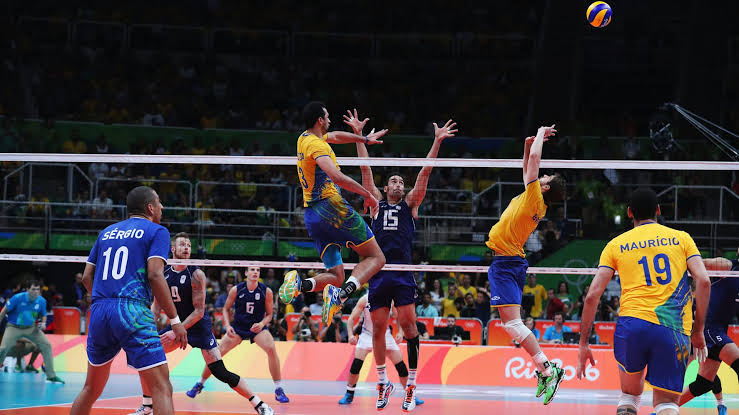 Volleyball is one of the most popular and dynamic team sports in the world, enjoyed by people of all ages and skill levels. Whether played on an indoor court, on the beach, or in a backyard, volleyball combines athleticism, strategy, and teamwork in a fast-paced game that demands both physical and mental agility. Originating in the United States in the late 19th century, the sport has evolved into a global phenomenon with millions of fans and professional athletes competing at the highest levels.
Volleyball is one of the most popular and dynamic team sports in the world, enjoyed by people of all ages and skill levels. Whether played on an indoor court, on the beach, or in a backyard, volleyball combines athleticism, strategy, and teamwork in a fast-paced game that demands both physical and mental agility. Originating in the United States in the late 19th century, the sport has evolved into a global phenomenon with millions of fans and professional athletes competing at the highest levels.
History and Origins
Volleyball was invented in 1895 by William G. Morgan, a physical education instructor at the YMCA in Holyoke, Massachusetts. Morgan wanted to create a new game that combined elements of basketball, baseball, tennis, and handball, yet was less physically demanding than basketball. He initially named the game “Mintonette”, but it was later renamed “volleyball” due to the volleying nature of the ball during play.
By the early 20th century, volleyball had spread to other countries, particularly through the efforts of the YMCA. It was introduced to the Olympic Games in 1964 for men and women, further increasing its popularity around the globe. Over the decades, variations such as beach volleyball, sitting volleyball, and snow volleyball have developed, each with unique rules and appeal.
Basic Rules and Gameplay
Volleyball is typically played by two teams of six players each on a rectangular court divided by a net. The objective is to send the ball over the net and make it land in the opponent’s court, while preventing the same from happening on one’s own side.
- A match is usually played as a best-of-five sets.
- The first four sets are played to 25 points, and the fifth set (if needed) is played to 15 points.
- A team must win a set by at least two points.
Each team is allowed three touches to return the ball over the net: typically a bump (or pass), a set, and a spike (or attack). Players rotate in a clockwise direction after winning a serve from the opposing team. This rotation ensures that all players take turns playing in both front and back court positions.
Positions and Roles
Each player has a specific role and position, contributing to the team’s overall performance:
- Setter: The playmaker, responsible for setting up the ball for attackers.
- Outside Hitter (Left-Side Hitter): Often the primary attacker, also involved in passing.
- Opposite Hitter (Right-Side Hitter): Balances offensive and defensive play, often blocks against the opponent’s best hitter.
- Middle Blocker: Specializes in blocking and quick attacks.
- Libero: A defensive specialist who wears a different color jersey and cannot attack or serve; focuses on receiving serves and digging spikes.
- Defensive Specialist: Substitutes for back-row players to strengthen defense.
Skills and Techniques
Volleyball requires a blend of specific skills and sharp reflexes:
- Serving – The initial act to put the ball in play; can be underhand or overhand.
- Passing – Using the forearms to receive and control the ball after a serve or attack.
- Setting – A precise touch using the fingers to set up a spike.
- Spiking – Forcefully hitting the ball downward into the opponent’s court.
- Blocking – A defensive move to stop or deflect the ball at the net.
- Digging – Diving or reaching low to save the ball from hitting the floor.
These techniques require hours of training, teamwork, and synchronization.
Types of Volleyball
- Indoor Volleyball: The standard form played with six players per team on a hard court. It is an Olympic sport and includes professional leagues worldwide.
- Beach Volleyball: Played on sand with two players per team. Introduced to the Olympics in 1996, it emphasizes endurance, agility, and communication.
- Sitting Volleyball: A Paralympic sport for athletes with physical impairments, played on a smaller court with a lower net.
- Snow Volleyball: A relatively new version of the sport played on snow, gaining traction in colder regions and introduced in demonstration events.
Volleyball as a Competitive Sport
Internationally, volleyball is governed by the Fédération Internationale de Volleyball (FIVB). The sport enjoys a strong presence in countries like Brazil, the United States, Russia, Italy, China, Japan, and Poland, where leagues are highly competitive, and national teams are dominant in global tournaments.
The Olympic Games, FIVB World Championship, World Cup, and Nations League are among the premier events for indoor volleyball. For beach volleyball, the FIVB Beach Volleyball World Tour and World Championships attract top-level competitors.
Health Benefits and Physical Fitness
Volleyball provides numerous health and fitness benefits:
- Cardiovascular fitness: Regular play boosts heart health and stamina.
- Muscle strength: Enhances upper body, leg, and core strength.
- Coordination and reflexes: Improves hand-eye coordination and quick decision-making.
- Teamwork and communication: Encourages social interaction and strategic thinking.
- Mental wellness: Reduces stress and builds confidence.
It is also adaptable for recreational play, making it a lifelong sport for fitness and fun.
Cultural Impact and Popularity
Volleyball is not just a sport but also a social and cultural activity. From beaches in Rio de Janeiro to school gyms in Tokyo, volleyball brings people together. It is especially popular in schools and universities, where it fosters teamwork, discipline, and leadership. In some countries, volleyball has become a source of national pride due to the success of their national teams.
The rise of televised matches and social media has further fueled the sport’s visibility, turning top players like Giba, Karch Kiraly, Zhu Ting, and Wilfredo León into international icons.
Volleyball is a versatile and exhilarating sport that has captured hearts around the world. Its blend of skill, speed, power, and cooperation makes it both thrilling to play and fascinating to watch. From its humble beginnings in a YMCA gym to the grandeur of Olympic arenas, volleyball continues to evolve while staying true to its core values of teamwork, sportsmanship, and athletic excellence. Whether you’re a casual player or an aspiring champion, volleyball offers something for everyone.







